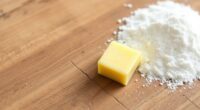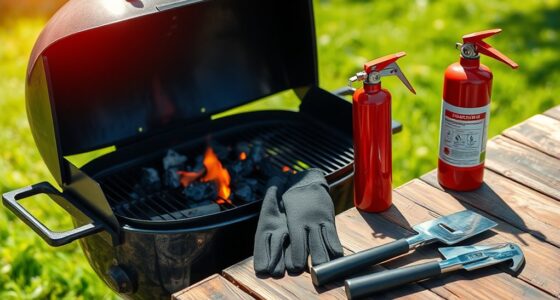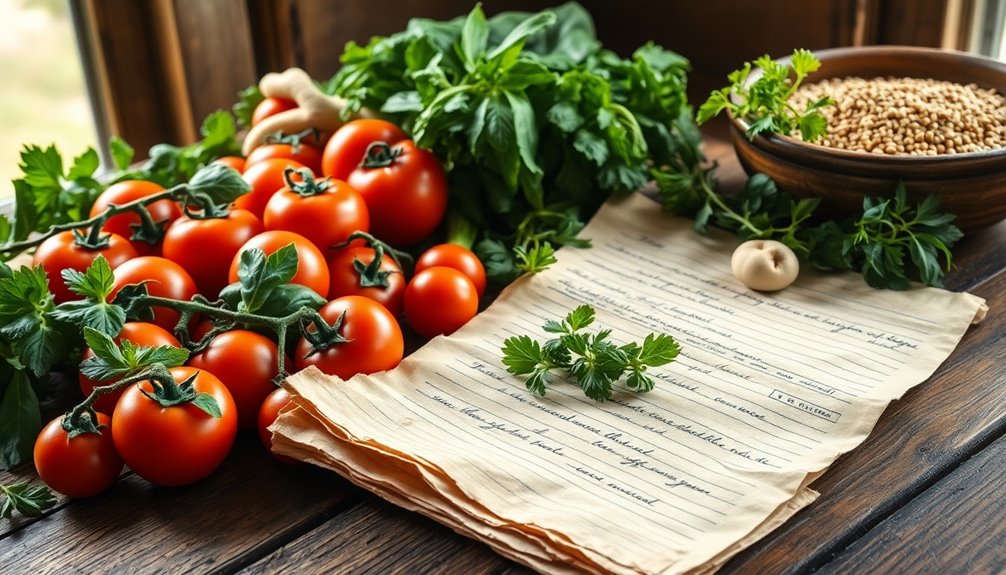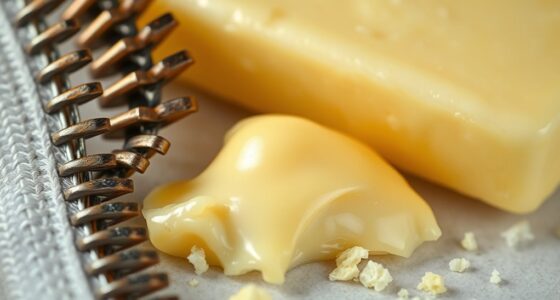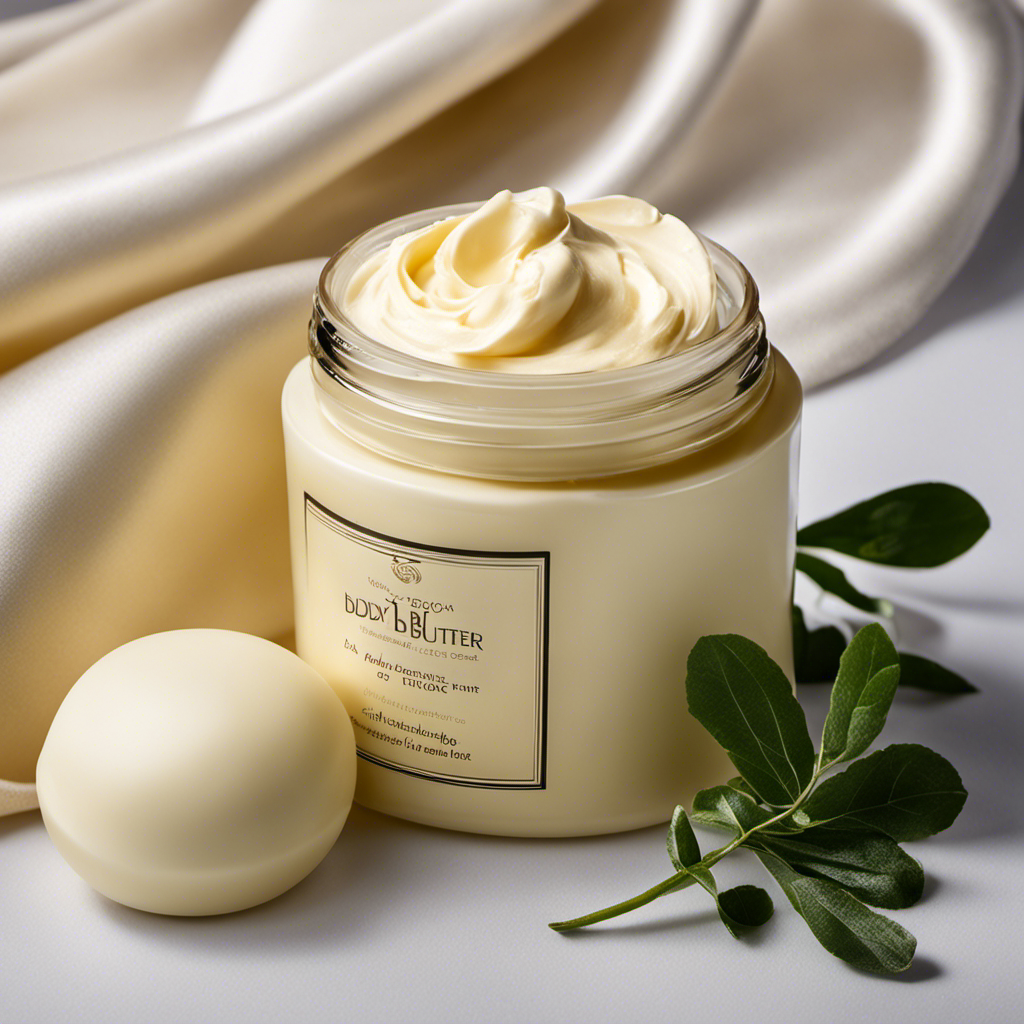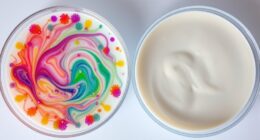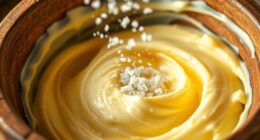To prevent rust on your garden tools, try applying a thin, even layer of butter after cleaning and drying them thoroughly. Butter forms a natural protective barrier that blocks moisture and air, slowing oxidation. Make sure to cover all surfaces and reapply as needed, especially after cleaning or use. Using butter is a simple, cost-effective method that can extend your tools’ lifespan—continue exploring how this trick works so effectively.
Key Takeaways
- Clean and dry garden tools thoroughly before applying butter to ensure proper adhesion and effectiveness.
- Spread a thin, even layer of butter on all surfaces, including crevices, to create a moisture barrier.
- Use a steady hand to avoid drips and ensure complete coverage for optimal rust prevention.
- Reapply butter regularly, especially after cleaning or use, to maintain continuous protection against moisture.
- Store tools in a dry, ventilated area to maximize the rust-resistant benefits of the butter coating.
Why Rust Damages Garden Tools
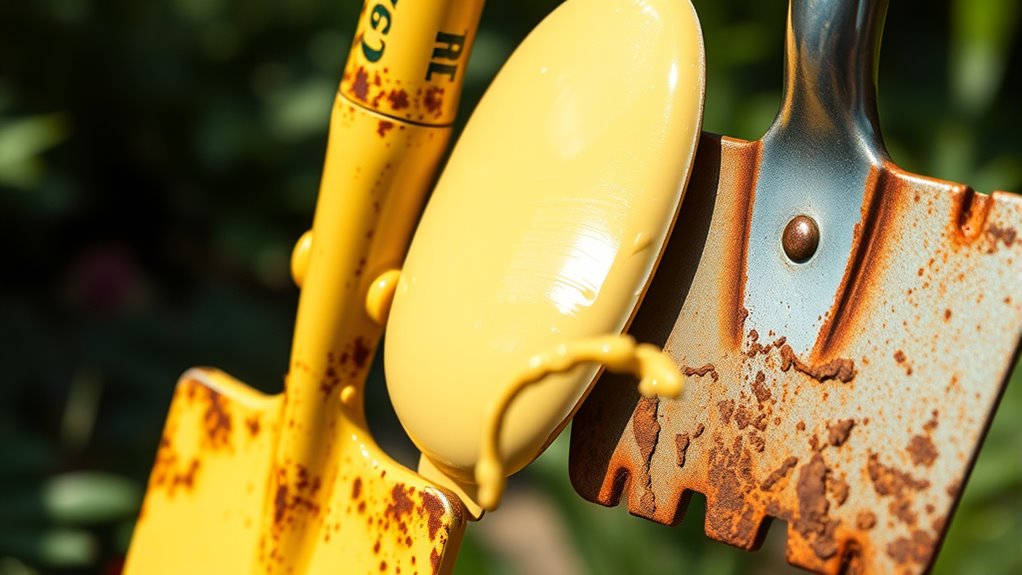
Rust damages garden tools because it causes metal to weaken and become brittle over time. When rust develops, it eats away at the metal’s surface, compromising the tool’s strength and functionality. This deterioration shortens the tool’s lifespan and reduces its effectiveness during gardening tasks. Rust also creates rough surfaces that can cause injuries or make cleaning more difficult. To maximize tool longevity, rust prevention is essential. Applying protective coatings or storing tools properly helps keep moisture away and slows down rust formation. Without rust prevention, your garden tools will wear out faster, leading to more frequent replacements and higher costs. Understanding how rust damages tools highlights the importance of maintenance and protective measures to keep your tools in top shape for years to come.
The Science Behind Butter as a Rust Barrier

Butter creates a protective coating that shields metal from moisture and air. Its fat content forms a barrier, slowing down the oxidation process that causes rust. Understanding how this coating works helps explain why butter can be an effective rust barrier. Additionally, applying this method can be a creative solution for maintaining garden tools without harsh chemicals.
Butter’s Protective Coating
While rust typically damages metal by causing corrosion, applying a layer of butter creates a temporary barrier that can help protect surfaces from moisture and oxidation. Butter’s natural fats form a coating that shields the metal, reducing contact with water and air, which are key factors in metal corrosion. This protective barrier slows down the rusting process, giving your tools a brief reprieve from deterioration. The fat molecules in butter fill small imperfections on the metal’s surface, preventing moisture from reaching the bare metal. Although this coating isn’t permanent, it’s an effective, simple method to extend the life of garden tools in a pinch. By creating a physical barrier, butter temporarily guards against rust, making it an handy, natural rust preventative. Additionally, understanding contrast ratio can help in assessing how well the coating might reflect light and influence visual inspection of the tools.
Oxidation Inhibition Process
The effectiveness of butter as a rust barrier lies in its ability to inhibit oxidation, the chemical process responsible for metal deterioration. When you apply butter, it forms a protective coating that blocks moisture and oxygen from reaching the metal surface. This barrier reduces the chances of corrosion, effectively preventing rust formation. Butter’s natural fats and oils create a physical shield, slowing down the oxidation process that causes metal to corrode. By applying butter, you establish a simple yet effective corrosion prevention method that keeps your garden tools in better condition. The butter’s coating acts as a temporary protective layer, shielding the metal from environmental elements. This oxidation inhibition process is a quick, accessible way to extend the life of your tools without chemicals or expensive treatments. Additionally, understanding the oxidation process can help you better appreciate how protective layers work to prevent rust.
Preparing Your Tools for Butter Coating
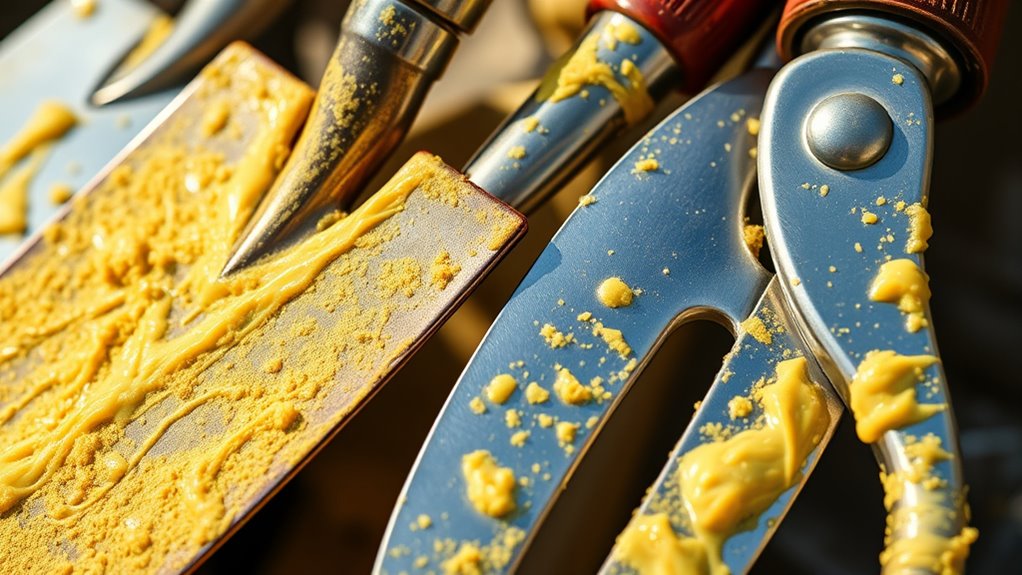
Before applying butter as a rust barrier, make certain your tools are clean and dry to prevent moisture buildup. Spread the butter in an even layer to cover all surfaces thoroughly. Choose a suitable butter that adheres well and resists melting or sliding off during use. Additionally, selecting best laundry detergents can help keep your tools free from residues that may promote rust formation.
Clean and Dry Tools
Ensuring your tools are clean and dry is a vital first step before applying a butter coating. Dirt and moisture can cause rust to develop despite the coating. Take time to scrub off any soil, sap, or debris from your garden bed tools using a stiff brush or cloth. Once clean, dry them thoroughly to prevent moisture from lingering. Properly dried tools will adhere better to the butter and offer longer rust protection. Keep track of your watering schedule to avoid exposing tools to excess moisture. Use the following table for quick reference:
| Step | Tip |
|---|---|
| Cleaning | Use a stiff brush or cloth |
| Drying | Air dry or wipe with a towel |
| Moisture check | Ensure no water remains |
| Storage | Store in a dry place |
| Maintenance reminder | Regularly inspect tools |
Additionally, understanding regional weather patterns can help you plan your tool maintenance routine to prevent rust formation.
Apply Even Layer
Have you prepared your tools properly? Making sure an even layer is essential for effective rust prevention. Use smooth, consistent coverage techniques to apply the butter uniformly across the surface. Work in small sections to maintain control and prevent uneven spots. Keep your strokes steady and avoid over-application, which can lead to drips or missed areas. Check your work regularly to maintain layer consistency, covering all crevices and flat surfaces. A thin, even coat is more effective than thick layers that may crack or peel. Remember, the goal is complete coverage with a smooth finish, so take your time and focus on precision. Proper application now ensures your tools stay protected and rust-free longer. Additionally, understanding AI Security concerns can help you stay aware of potential vulnerabilities in automated tools or systems you may use.
Choose Suitable Butter
Choosing the right butter is essential for a smooth and effective rust prevention process. When selecting a suitable butter, consider its consistency, adhesion, and resistance to heat and moisture. A good butter should spread easily without dripping and form a thin, even coating on your tools. The selection criteria include checking for natural, food-grade options that won’t damage metal or leave sticky residues. Avoid butters that are too soft or oily, as they may run off or become ineffective over time. Harder butters can be difficult to apply evenly. Opt for a butter that melts smoothly at low temperatures and stays stable during application. Additionally, ensure the butter has good adhesion properties to stay firmly on the tool surface during storage and use. By carefully choosing your butter based on these criteria, you’ll ensure a durable, protective coating that keeps rust at bay.
Step-by-Step Guide to Applying Butter
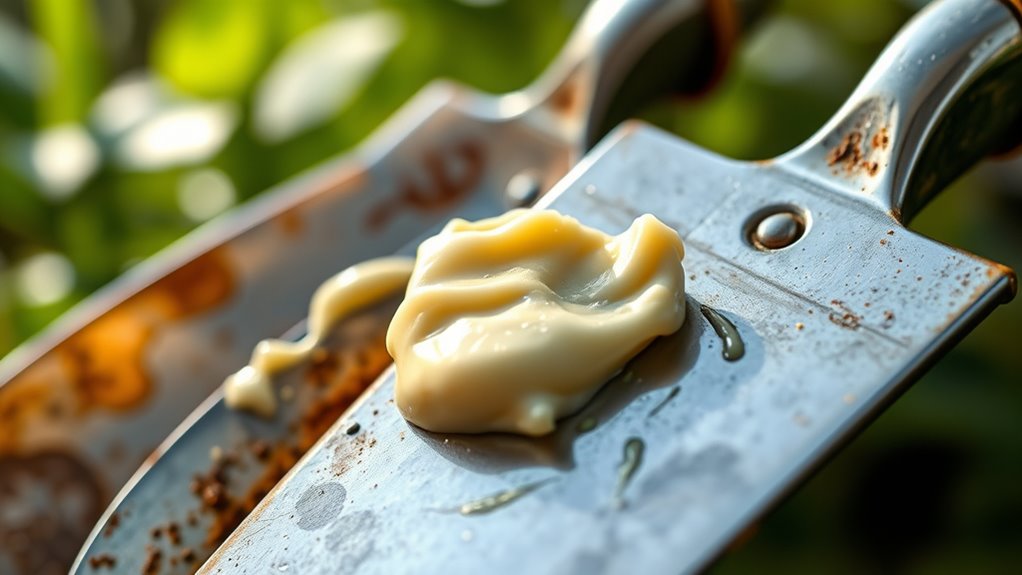
To effectively apply butter for rust prevention, start by cleaning the surface thoroughly to remove dirt, grease, and loose rust. Use a wire brush or cloth to make sure the metal is clean and dry. If your tools are stored in a garden storage shed, wipe them down before applying the butter to prevent trapped moisture. For tools that need sharpening, do this first to expose fresh metal, which helps the butter adhere better. Apply a thin, even layer of butter using a cloth or brush, focusing on all metal surfaces, especially vulnerable areas. Make certain no spots are missed. This simple step creates a protective barrier that prevents rust and keeps your tools in top shape for future garden tasks. Additionally, using proper storage techniques can further enhance rust prevention and extend the lifespan of your garden tools.
Tips for Effective and Even Coverage

Want to guarantee your rust-preventive butter provides maximum protection? Start by applying a thin, even layer across all surfaces of your tools. Use a brush or cloth to spread the butter smoothly, ensuring no spots are missed. Focus on hard-to-reach areas and joints, where moisture can accumulate. Consistent coverage enhances coating durability and helps prevent rust effectively. Avoid over-application, which can cause uneven patches or drips that reduce tool longevity. Regularly check for missed spots and reapply as needed, especially after cleaning or use. Proper coverage creates a uniform barrier, maximizing rust resistance and extending the life of your tools. Remember, a well-applied coat promotes durability and keeps your tools in top shape longer. For added protection, consider precious metals investment as a hedge against corrosion or economic fluctuations.
Benefits of Using Butter Over Commercial Products

Have you ever considered that butter might offer better rust protection than commercial products? Using butter creates a natural, inexpensive barrier that can extend your tool’s longevity. It’s cost-effective because you likely already have butter at home, unlike specialized rust inhibitors. Plus, butter’s coating helps prevent moisture contact, reducing rust formation. Here’s a quick comparison:
| Aspect | Butter | Commercial Products |
|---|---|---|
| Tool Longevity | Prolongs tools’ lifespan | Varies, often less durable |
| Cost Effectiveness | Very affordable | Can be pricey |
| Ease of Use | Simple, kitchen staple | Sometimes complicated |
This approach saves money while effectively protecting your tools, making butter a surprisingly smart choice.
Maintenance and Reapplication Strategies

Regular maintenance is essential to guarantee your tools remain rust-free when using butter as a protective coating. After each use, inspect your tools for any signs of rust or wear. Reapply butter evenly, especially on areas prone to moisture exposure, to maintain a barrier. Keep your tools sharp through regular tool sharpening; sharp blades resist rust better and perform more efficiently. When storing your tools, use proper storage techniques like hanging them in a dry, ventilated space or keeping them in a toolbox with silica gel packs to absorb moisture. Reapplication of butter should occur periodically, especially after cleaning or exposure to rain. Consistent maintenance not only prolongs their lifespan but also ensures your tools stay in top shape for gardening tasks.
Additional Household Items for Tool Preservation

In addition to butter, several common household items can help preserve your tools and protect them from rust. First, household wax creates a protective barrier that repels moisture, keeping metal surfaces dry. Second, olive oil acts as a natural rust inhibitor; apply a thin layer to prevent oxidation. Third, you can use mineral oil for a more durable coating that penetrates into crevices and provides long-lasting protection. These items are easy to find and simple to use—just clean your tools, apply the chosen item, and wipe off excess. Regular maintenance with household wax, olive oil, or mineral oil can extend the life of your tools, minimizing rust and keeping them in top shape for your gardening or DIY projects.
Frequently Asked Questions
Can Butter Be Used on All Types of Garden Tools?
You might wonder if butter works on all garden tools, but it’s not the best idea. While it can temporarily prevent rust, butter isn’t suitable for plant safety or long-term tool maintenance. It can attract dirt and pests, leading to damage. For ideal care, use proper rust inhibitors or oils designed for garden tools, ensuring your tools stay in good shape and safe for your plants.
How Long Does the Butter Coating Last Before Reapplication?
You might think butter lasts forever, but the truth is, its anti-rust magic fades quickly. Usually, a butter coating on garden tools lasts about a week, depending on exposure to weather and use. For effective rust prevention, expect to reapply every 5 to 7 days. So, don’t get too attached—this butter trick isn’t a long-term solution, and reapplication frequency is key to keeping rust at bay.
Is Butter Safe for Plants Near Treated Tools?
You’re wondering if butter is safe for plants near treated tools. While butter isn’t highly toxic, it can attract pests and cause mold, potentially harming your plants. For plant safety, avoid using butter close to your garden, as it may create an unhealthy environment. Instead, opt for safer rust-preventive options. Remember, butter toxicity isn’t well-studied in garden settings, so it’s best to keep it away from your plants.
Does Butter Attract Pests or Insects to the Tools?
You might wonder if butter on your garden tools attracts pests or insects. It can cause pest attraction, as the greasy residue may draw ants, flies, or other insects looking for food. This increases the risk of insect infestation around your tools and garden area. To avoid this, consider using a safer, less attractive rust-proof coating that doesn’t invite pests or compromise your garden’s health.
Can Butter Coating Be Applied in Humid or Rainy Conditions?
You might think it’s a breeze to apply butter coating in humid or rainy conditions, but don’t count on it. Moisture resistance becomes a real challenge, as the damp environment can cause the butter to wash away or mold to develop. Applying in such weather increases application challenges, preventing a proper seal. To protect your tools effectively, wait for dry weather, ensuring the coating adheres well and offers lasting rust prevention.
Conclusion
Using butter on your garden tools is an easy, cost-effective way to prevent rust. Did you know that rust can reduce a tool’s lifespan by up to 70%? By applying butter, you create a protective barrier that keeps moisture out and extends your tools’ life. With just a simple coating, you can preserve your tools for seasons to come. Give it a try—you’ll be amazed at how well this household trick works!

